A Close Encounter with the Columbans in the Third World
By Fr Jovito Dales
Father Jovito shares how his childhood wonder at the ‘huge house inhabited by white strangers’ in Ozamiz City led him ultimately to leave a good job in the bank and become a Columban priest in Peru. He is now back in the Philippines as vocation director. He will be very happy to hear from any young man interested in following his footsteps at seladmj@yahoo.com
‘I pray especially for you to have the gifts of the Spirit of Discernment and the Spirit of Mission.’ That was the prayer of Columban Fr Desmond Hartford when he confirmed me in January 1997 in the chapel of the Carmelite Sisters, Marawi City, Lanao del Sur. After finding no proof of my confirmation Monsignor Des, then Apostolic Administrator of the Prelature of Marawi, suggested that I be confirmed there. He looked for my baptismal godparents, whom I had never met. He eventually found them and brought them to the ceremony. That was an unforgettable event precisely because I was born and baptized in Marawi City in 1969, but grew up in Catadman, Ozamiz City, when we left the war-torn place in 1972.
Encounter with the White Strangers
My first encounter with the Columbans was during my elementary years. Going to school I passed by a huge house inhabited by white strangers. We called it ‘Ang Palasyo’, ‘The Palace’, as it was the biggest house in town. Those passing by were curious about the overwhelmingly big house, about those white men what they were they doing in our place. Their towering height seemed threatening to little kids like me. But I was not afraid of them because they were very nice. They tried to speak and ask questions in Bisaya, and would even laugh as they were corrected. I learned that they were missionary priests and that Ang Palasyo was the central house of the Columban Fathers in Ozamiz City. Most of the Columbans I met in Mindanao were people-oriented, lived a simple lifestyle, were very down to earth and courageous, and chose to stay despite the danger – things that captivated me as I was silently discerning my vocation.
The desire to be like them gradually grew. I wanted to enter the seminary after college but my mother got very ill. After finishing my degree in Commerce, majoring in Accounting, in 1990 I looked for a job to help my family. Fortunately, I found one in a bank where I worked for more than six years.
While working, an opportunity for reconnecting with the Columbans came when Fr Frank Baragry invited me to join a retreat-giving team. He became my regular spiritual companion. I had the opportunity to meet more Columbans during weekend recollections, retreats and some Columban gatherings. I also got to see the inside of the Palasyo. It was truly big with high ceilings and oversized beds, at least for me! Not built for Pinoys! In the mirror of the comfort room (rest room), I could only see the tip of my head! It was very amusing.
More Inspiring Encounters
I came to know the late Fr Patrick Steen when he invited us to give a recollection to his parishioners in Sinacaban, Misamis Occidental. People-oriented, he would always wear his contagious smile going to mountain communities.
While working in the bank, I happened to meet Fr John Hickey whose simplicity and gentleness were very evident. I appreciated him more when I visited his parish in Dinas, Zamboanga del Sur, with the retreat group. A veterinarian, he had many pets such as rabbits and goats around the place During the retreat some parishioners shared about their experience with an occult group called Tadtad, known to kill people they were suspicious of by cutting off parts of their bodies. Traumatized, some were crying and shaking in fear. Despite the danger in that area Father John chose to stay.
‘If I were to be a Columban like him, would I be able to remain calm and passionate in my ministry in the midst of danger?’ I asked myself.
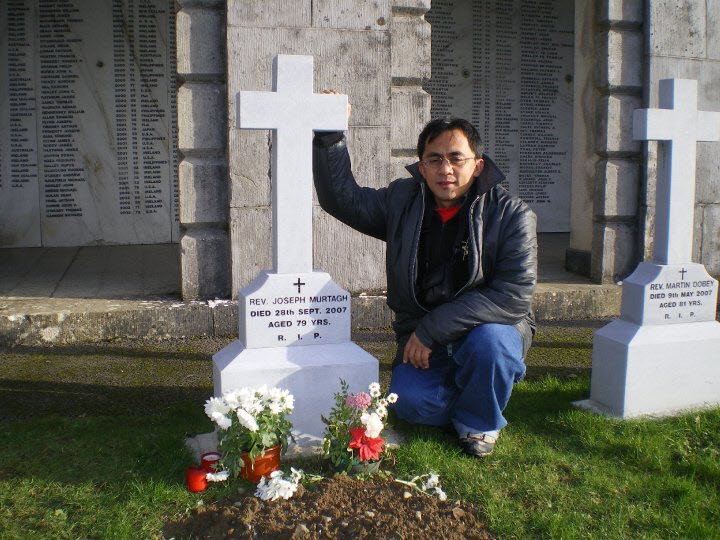
Fr Vito at Fr Murtagh's graveyard.
The late Fr Joe Murtagh was another who inspired me. You would never know the suffering he was going through because he was always smiling. I learned that he had a very painful form of Multiple Sclerosis (MS) but he didn’t complain. The person who told me said that he could be seen at night walking to-and-fro in the lobby of the Palasyo to make the pain bearable. When I was in Chicago in 1998 he faxed me a hand-written letter that I keep as a remembrance of someone who showed great dedication and courage in the midst of suffering.
Knowing each of them, meeting them in different places and circumstances enabled me to reflect more on my calling. These encounters gave me the opportunity to know the white people in the Palasyo better and what they were into. During my formation years, when I sometimes found things difficult and could hardly understand what was happening, they helped me find meaning in what I was doing. They really touched me profoundly.
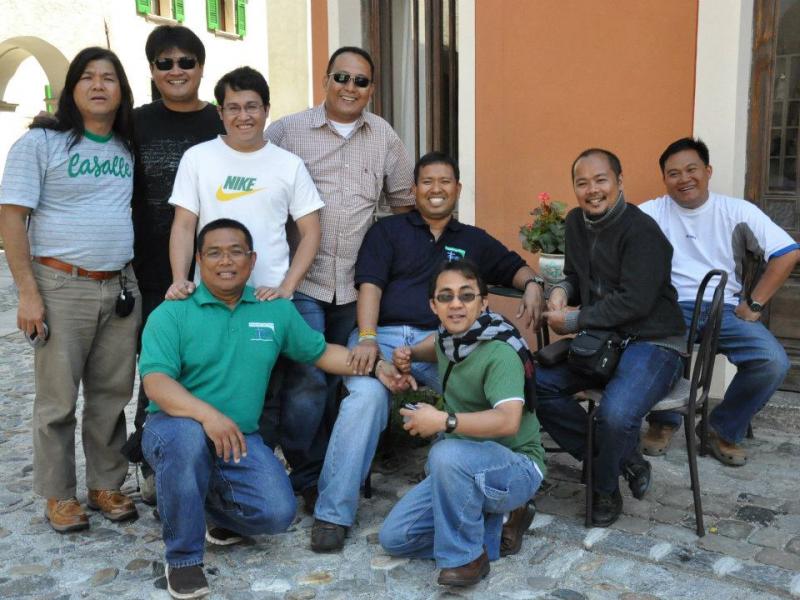
Filipino Columban Fathers
Becoming a Columban
I joined the Columbans in June 1997. The following year, with the opening of our International Theologate in Chicago, I was sent to the United States for theological studies. In 2002 I left for Bolivia for five months for an intensive course in Spanish language and then proceeded to Peru for my First Missionary Assignment (FMA). I had a meaningful experience in Peru with an interruption in 2003 when my father died.
The Columbans are family-orientated. The fact that I was able to come home for my Dad’s funeral made me even more appreciative of them. I finished my theology in 2005. The following years until my priestly ordination were spent in the Columban parish of Our Lady of Remedies, Malate, Manila. I was ordained deacon there in 2006. It was there that I learned more about poverty in my own country.
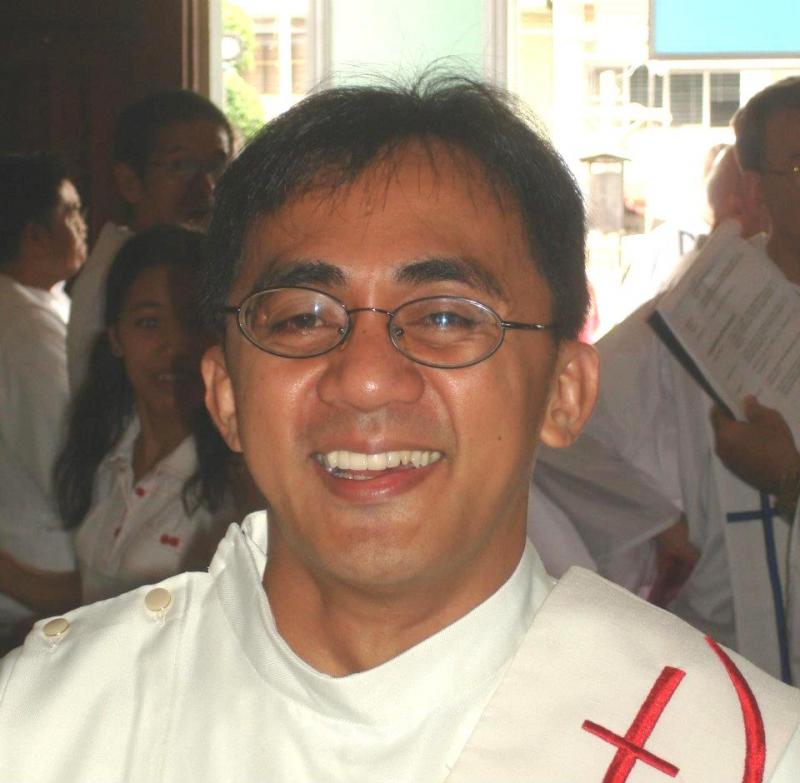
One day I asked Fr John Leydon, the parish priest, to allow me to immerse myself for a few days with some sidewalk vendors around the church. I accompanied the family of Ate Evelyn in selling cigarettes, candies, and coffee at nighttime. She was the mother of four children. Her husband was a tricycle driver. Ate Evelyn had to sell from 8pm to 4am the following day. Arriving home she still had to do some household chores before taking a few hours sleep and begin her daily routine as a mother. The first night with them in the street was exciting. However, when I had my sleep from 4 am to 8 am, I wasn’t able to get up because of dizziness. I could imagine the lack of rest that Ate Evelyn had to go through. Sadly, her earnings sometimes weren’t even enough for her family’s daily needs. It was through her and the other street vendors that the line in the Our Father truly came alive: ‘Give us this day our daily bread!’ They struggled to put food on the table every day. Now, every time I pray those words I remember Ate Evelyn, her family and others who have to struggle every day to find food.
I was ordained as a priest on 4 January 2007 at Immaculate Conception Cathedral, Ozamiz City, by Archbishop Jesus A. Dosado CM and worked in Agusan Parish in Cagayan de Oro City for one year with Fr Dick Pankratz, the parish priest. I was back in Peru from 2008 until 2011. I found the Peruvians still warm, friendly and vibrant as they engaged in mission with sincerity, dedication, and profound faith. I surely experienced the highs and lows in mission life in Peru. However, I left there with so much gratitude in my heart, as expressed wonderfully in the famous line from a Spanish song: ‘Gracias a la vida que me ha dado tanto’ (Thanks to life, which has given me so much!).
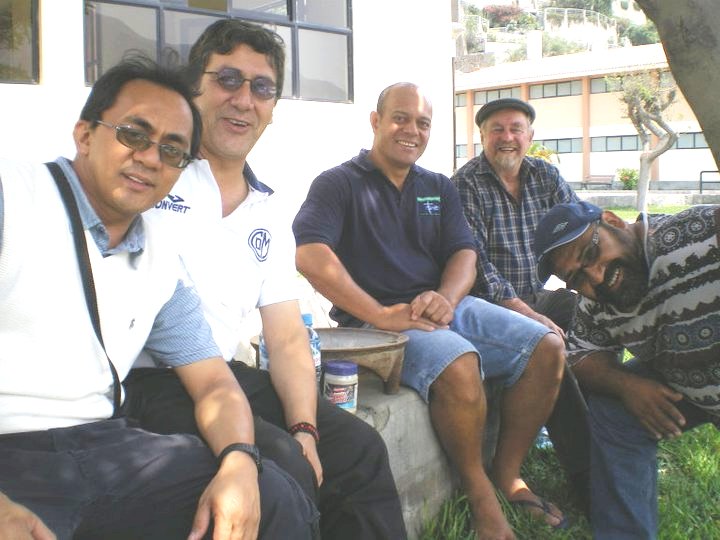
With the Columban Fathers in Peru
Being into different places broadened my perspective of ‘me and others’. I become more appreciative of my own culture as I learned to be more accepting of others. A common thing among Columbans is that we work with the underprivileged to somehow bring to them the Christ that each one knows; and much of what I know of Christ has been through my dealings with the people. A give-and-take process, indeed.
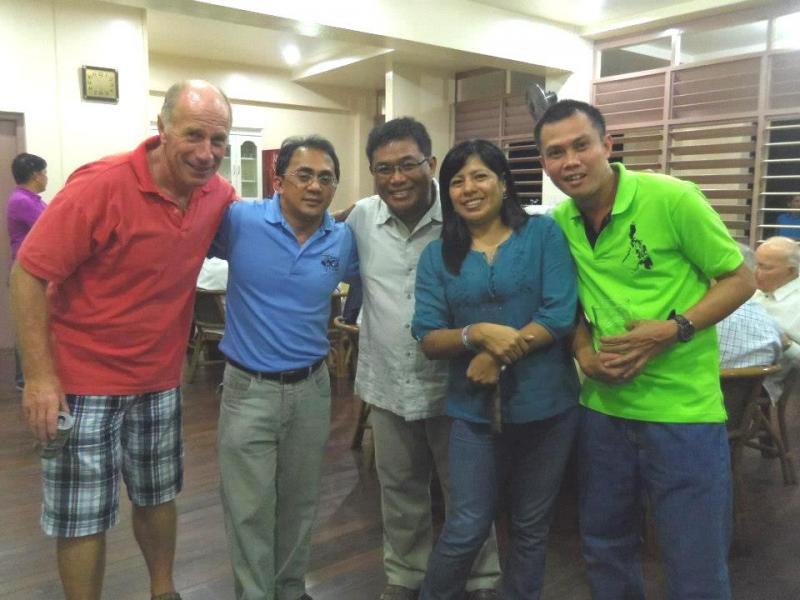
Vocation Director
Now I am working with the Vocation Ministry in the Philippines since June 2012. It is challenging as I feel like a fisherman without knowing where to fish. I have to depend on the previous coordinators’ insights. I try to listen to their experiences and at the same time evaluate them from my own experience. The interesting part of the job is that it reorients me to my own culture as I go to parts of the Philippines I’ve never been before. I am learning to appreciate the diversity of Filipino dialects and languages, and learning more deeply the struggles of the people, particularly of the Ate Evelyns in my country. I am glad of the opportunities to talk with groups about the Columbans and our missions. I have become hopeful for there are young men who inquire about the possibility of joining us. As they express their interest in what makes up their lives, I am reminded of my own vocation story.
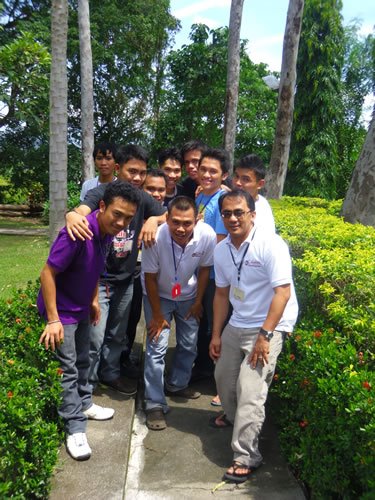 Fr Jovito, Bernie Durangparang and some searchers after a vocation recollection.
Fr Jovito, Bernie Durangparang and some searchers after a vocation recollection.
Now more than ever I find the prayer of Fr Des Hartford even more appealing. I pray for those two gifts especially as a vocation director. The gift of the Spirit of Discernment: to help each inquirer listen to and respond to his own calling. And the gift of the Spirit of Mission: submission to the work itself.
I see my role the way I see mission. This is not my mission but God’s mission, one that is full of frustrations for it is bound by its limitations. But it is also filled with joy for it provides me with the opportunity to meet people from all walks of life whose faith is, at times, stronger than mine. I believe that with the two beautiful gifts I’m praying for, I am also growing in faith and trust in the One who calls.
Canto para la Lima de Hoy (A Song for the Lima of Today)
Sung by Columban Fr Diego Rojas Cabrera, ‘Padre Diego’
Mercedes Sosa Gracias a La Vida
Gracias a la Vida que me ha dado tanto
me dio dos luceros que cuando los abro
perfecto distingo lo negro del blanco
y en el alto cielo su fondo estrellado
y en las multitudes el hombre que yo amo.
Gracias a la vida, que me ha dado tanto
me ha dado el oido que en todo su ancho
graba noche y dia grillos y canarios
martillos, turbinas, ladridos, chubascos
y la voz tan tierna de mi bien amado.
Gracias a la Vida que me ha dado tanto
me ha dado el sonido y el abedecedario
con él las palabras que pienso y declaro
madre amigo hermano y luz alumbrando,
la ruta del alma del que estoy amando.
Gracias a la Vida que me ha dado tanto
me ha dado la marcha de mis pies cansados
con ellos anduve ciudades y charcos,
playas y desiertos montañas y llanos
y la casa tuya, tu calle y tu patio.
Gracias a la Vida que me ha dado tanto
me dio el corazón que agita su marco
cuando miro el fruto del cerebro humano,
cuando miro el bueno tan lejos del malo,
cuando miro el fondo de tus ojos claros.
Gracias a la Vida que me ha dado tanto
me ha dado la risa y me ha dado el llanto,
asi yo distingo dicha de quebranto
los dos materiales que forman mi canto
y el canto de ustedes que es el mismo canto
y el canto de todos que es mi propio canto.
Gracias a la Vida
Gracias a la Vida
Gracias a la Vida
Gracias a la Vida
English translation
Mercedes Sosa - Thanks to life or Thanks Giving (Violeta Parra)
Thanks to life, which has given me so much.
It gave me two beams of light (my eyes), that when opened,
can perfectly distinguish black from white
and in the sky above, her starry backdrop,
and from among the multitude
the one that I love.
Thanks to life, which has given me so much.
It gave me an ear that, in all of its breadth
records— night and day—crickets and canaries,
hammers and turbines and bricks and storms,
and the tender voice of my beloved.
Thanks to life, which has given me so much.
It gave me sound and the alphabet.
With them the words that I think and declare:
‘Mother’, ‘Friend’, ‘Brother’ and the light shining.
The route of the soul from which comes love.
Thanks to life, which has given me so much.
It gave me the ability to walk with my tired feet.
With them I have traversed cities and puddles,
valleys and deserts, mountains and plains.
And your house, your street and your patio.
Thanks to life, which has given me so much.
It gave me a heart, that causes my frame to shudder,
when I see the fruit of the human brain,
when I see good so far from bad,
when I see within the clarity of your eyes...
Thanks to life, which has given me so much.
It gave me laughter and it gave me longing.
With them I distinguish happiness and pain—
the two materials from which my songs are formed,
and your song, as well, which is the same song.
And everyone's song, which is my very song.
Thanks to life (Thanks Giving)
Thanks to life
Thanks to life
Thanks to life
